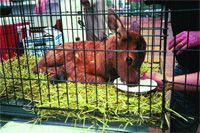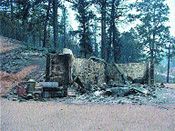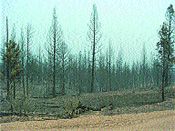Facing fire: DVMs rescue animals amid chaos
As Colorado and Arizona residents return to the charred remains of their homes and neighborhoods, volunteer veterinarians get back their daily life after donating time and resources to saving thousands of abandoned pets and injured wildlife.
As Colorado and Arizona residents return to the charred remains of their homes and neighborhoods, volunteer veterinarians get back their daily life after donating time and resources to saving thousands of abandoned pets and injured wildlife.

Dr. Lorna Lanman
At presstime, no veterinary hospitals were known to have been destroyed in Arizona's huge Rodeo-Chediski inferno, which burned half a million acres, or Colorado's 137,000-acre Hayman fire. But the number of animals dispersed by evacuated veterinary clinics alone brought its own kind of confusion.
Dr. Jack Duncan, who practices in Eagar, Arizona, an hour east of evacuated Show Low, sheltered more than 200 of the town's abandoned animals in his clinic, which is designed to house 50.

Veterinarians were called into crisis management as a half million acres burned in Arizona. In the Colorado fires, 137,000 acres were lost. American Humane Association volunteers camped outside of Show Low, Ariz., to tend to displaced wildlife.
"We're absolutely swamped dealing with emergencies, and there's not another decent sized town for 100 miles," Duncan says. "At this point, we have no veterinary help, but they say they're coming."
To the rescue
Relief came in the form of Dr. Lorna Lanman, a Veterinary Medical Assistance Team (VMAT) member on the scene days before the federal disaster agency was deployed.
"When I arrived in Show Low, the smoke was so thick the lights in my car turned on in the afternoon," she says. "I had no idea what to expect. We immediately went out and started assessing the area; there were so many animals everywhere. People didn't have time to take their animals so they let them loose."
As fire loomed a quarter mile from their command center, Lanman, along with fellow veterinarians and rescue workers, set up a triage within the American Humane Association's truck.

A building on an Arizona horse farm, which housed 150 horses, fell victim to the blaze. The horses were all evacuated and spared. (Photo courtesy of Dr. Al Schleappe.)
"We saw everything from baby elk calves to burned bunnies," says Dr. Al Schleappe, who dropped everything and drove from his home in Gilbert, Ariz., five hours away, to volunteer at the scene with his wife, a veterinary technician.
"I had no idea what to expect. I just figured if there was something I could do to help, whether it was veterinary medicine or not, I could be there to lend whatever assistance I could."
State agencies unite
But despite DVM efforts, Arizona State Veterinarian Dr. Rick Willer says saving wildlife was not an easy task. Once wounded, wild animals tend to run, he says. Those found are usually critical, too injured to move.
"We're not seeing too much wildlife, so we're focusing on the animals left behind by owners without any feed or water," he says. "We have livestock running loose."

Dr. Al Schleappe
The blaze is the first disaster in Willer's 10-year state career that's required close interaction between the department of agriculture and state livestock officers.
"Sixty percent of households have at least one pet," he says. "When you talk about evacuating people, you obviously have animal issues from the start.
"There are supposedly over 1,000 head of horses being evacuated from Holbrook to Eager. Under the circumstances, I think we're doing a pretty darn good job."

Dr. Al Schleappe
Ahead of the flames
Working the Hayman fire, Dr. Kevin Dennison, co-owner of the Innermountain Humane Society southwest of Denver, says he's run into the same issues.
"The Hayman fire started as a small 200-acre fire by Lake George," he says. "The next day, the wind picked up and it just exploded.
"I was there. Literally, horses were being moved out with dogs and cats just in time. It's so hard to find facilities for these animals. It's one of the toughest issues we deal with."
Ben Drotar, leading veterinary efforts at each of the Colorado and Arizona fires as director of the American Humane Association's emergency services, says while some animals had critical needs, most were simply dehydrated.

Ben Drotar
"Nevertheless, all these animals were evaluated by a veterinarian," he says. "You got to hand it to these guys. They really came through. These veterinarians were real heroes out here."
AVMF Disaster Packets
The American Veterinary Medical Foundation (AVMF), established by the American Veterinary Medical Association, reimburses veterinarians up to $5,000 for out-of-pocket expenses in treating animals injured or affected in disasters such as earthquakes, fires or floods.
For more information, contact AVMF representative Susan Goldberg at (800) 248-2862 ext. 6688 or print the guidelines and application off the Web at www.avmf.org.